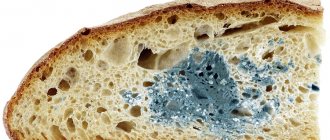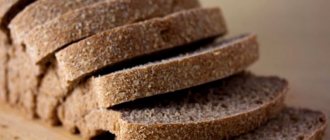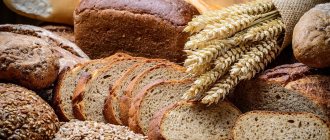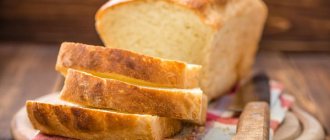If you look back several decades, you will notice the following pattern: bread could dry out in a few days, but not “bloom”, becoming moldy. Because there were no... plastic bags!
Bread was stored the old fashioned way - in fabric bags or wrapped in paper. And some housewives put it in a regular saucepan! After all, this is how our ancestors stored bread. And they knew a lot about it.
But then convenient plastic bags appeared, which replaced paper packaging, and bread safely moved into them.
Meanwhile, bread is a living product. Even after baking, it continues to “breathe”, releasing carbon dioxide, thanks to the yeast that participates in its production.
Bread placed in plastic simply suffocates. Fungus develops in it, mold appears, and housewives begin to blame the manufacturers for dishonesty.
But then how to store bread so that it remains fresh for several days? You need to think about this while still in the store. In some stores, sellers, having accepted bread from suppliers, immediately pack it in plastic bags, apparently with the aim of not having to return dried products, as well as to speed up the process of serving customers. Thus, they are doing a disservice, because bread most often arrives on store shelves practically from the oven - crispy and hot, and if it has already cooled down on the outside, it is still warm on the inside. When such bread is placed in a film bag, condensation accumulates on its inner walls, which becomes the culprit of product spoilage.
But what then to do with the bread that is sold immediately in sealed packages?
The fact is that factory packaging is made not of polyethylene, but of cellophane. Moreover, they are not completely sealed. If you look closely at them, you will notice many small holes, thanks to which the bread “breathes” and does not spoil or become stale.
There is only one conclusion: there is no need to store bread in polyethylene packaging.
What is mold?
Mold is a member of the fungal kingdom, which is separate in the classification of plants and animals. Common edible mushrooms also fall into this category. These are organisms that do not require chlorophyll, so they do not receive energy directly from the sun. This means that fungi must use plants and animals as a food source. This is why bread is moldy: because of the ingredients in its composition, it is an excellent source of food for many types of fungi.
What to do if the product is moldy
Most foods with visible signs of mold contamination should not be eaten. Molds poison food with mycotoxins, which can cause irreparable harm to the body. The poisons released by mold can cause liver damage, pulmonary edema, impaired kidney function, and even the development of cancer.
Food contaminated with mold should be thrown away, even if only 2-3 small colored spots appear on it. Do not forget that behind the visible part of the mycelium there are numerous invisible threads of the mycelium that penetrate the spoiled product like laser beams.
► Only hard cheeses, dry-cured sausages and dried meats can be “saved” and eaten. With meat products, it is enough to remove the plaque that appears on the surface, and with hard cheeses, cut off the top layer 1 cm thick.
► We mercilessly throw away the rest - including boiled sausages, sausages, ham, bread, sour cream, cottage cheese, ready-made meals, jam, berries, fruits and vegetables.
How does she get into our house?
Mold gets onto bread through spores in the air. Although you cannot see them, there are millions of them around you.
These spores can accumulate in dust around your home, which is kicked up by sweeping, wind, or simply someone passing by. Spores can enter your home, settle on the bread, and the mold process will begin. Mold lives and feeds on bread. That's why it can quickly cover an entire loaf if you let it. Mold reproduces at a high rate - sometimes it can double in size within an hour.
Which foods go moldy faster?
Mold loves moisture, so it attacks any food product that contains it. Products with a high level of humidity become infected faster than others, including vegetables (up to 96-97%), bread (30-50%), sausages (30-60%) and cheeses (20-40%).
The rate of mold contamination of products largely depends on storage conditions:
► Products in open packaging, wet greens, vegetables and fruits with damage and cuts will quickly become moldy.
► If the mycelium already “lives” on the walls of the refrigerator, kitchen cabinet or bread bin, mold will appear even on fresh food.
► If you put the product in a “non-breathable” plastic bag, the moisture released will settle on the walls and provoke accelerated development of the mycelium.
What kind of mold is there?
Penicillin is the first antibiotic created from the fungus penicillium chrysogenum, and this discovery belongs to Alexander Fleming, a great scientist. It is found in noble blue cheeses and is very beneficial for the body. But not all mold is beneficial. It comes in different colors.
Black most often covers old bread. Greenish-blue - cheese. Green fuzz usually develops on oranges that have been left in a humid environment for too long. Mushrooms are a great boon to humanity. Without yeast there would be no bread or beer. Mushrooms are used to make antibiotics, soy sauce, miso, sake, tofu, and many other products.
On the other hand, many plant diseases that result in their death are caused by mold. The Irish famine was caused by potato late blight. Most of America's great chestnut forests have been destroyed in 50 years by a fungus brought to the United States on a tree planted in a botanical garden. Fungi are responsible for trillions of dollars in food spoilage damage each year worldwide.
Choosing a bread box
Where is bread traditionally stored in the kitchen? The answer is obvious: in the bread bin. To ensure that the product does not spoil for a long time, you first need to choose it wisely. Which bread box is best? Let's consider the options.
- Plastic. Its advantage is practicality. The plastic container can be completely washed and treated with a disinfectant. It does not break and, unless excessive force is applied to it, does not break. A plastic bread bin is a good choice, as long as it doesn't emit a strong odor and has ventilation holes.
- Wooden. It is the most environmentally friendly. However, it does have its drawbacks. If it gets very wet or stays in the sun for a long time, the glued parts of the container dry out. In addition, it is very difficult to remove old dirt and grease from wood.
- Metal. Having chosen this version of the bread box, pay attention to what metal it is made of. The ideal option is stainless steel. It does not rust, does not absorb odors and does not form condensation.
You should not place the breadbox above the stove, or place it near the radiator in winter or on a too-highly lit windowsill in summer. Baked goods in it will quickly spoil.
Is mold a plant or a mushroom?
Have you ever opened a loaf of bread that has been sitting in the kitchen for a long time and seen dark colored stains? This is mold. What happens when you leave the bread open a little longer? The mold spreads quickly and all the bread turns green or black and looks very unappetizing.
But mold is a simple fungus that takes nutrients from bread for its growth and reproduction and damages its surface. Mold grows on bread from microscopic fungi belonging to various species. They come in different shapes and colors depending on the species.
Rhizopus stolonifer (black mold) is the most common mold on bread, which also grows very quickly. It also causes rotting of fruits and some infections in the human body. Microscopic pieces of moldy bread, known as spores, float in the air around us. They can be found on any surface and in any conditions. It is the spores that land on the surface of the bread, which can be left open under normal conditions, say, in the kitchen. They germinate and form colonies that begin to grow on the surface of the bread, absorbing all the moisture and nutrients from it. The growth rate of bread mold depends on several factors, and ambient temperature is the most important of them.
How mold “settles” on food
Invisible to the eye, spores (reproductive organs) of mold fungi are everywhere. They are present in the natural air environment around us along with other microorganisms - viruses and bacteria.
But mold spores don't fly through the air forever. When they enter a humid environment favorable for reproduction, they anchor and settle on the surface of the product, on which branching mycelium (mycelium) begins to grow rapidly. After some time, visible signs of infection appear on the food - colored spots, white coating or voluminous fluffy “caps”.
Causes of mold growth and ways to slow it down
Mold growth will be slowed down if bread is stored in the refrigerator. It should be noted that most molds thrive in temperatures above 70°C, and low refrigerator temperatures are unfavorable for mold. Place a slice of bread in the freezer and mold growth will stop completely until the temperature rises to a favorable temperature.
Why does bread get moldy? Bread mold is a living organism that requires moisture and oxygen to grow. The moisture in the plastic bag allows the fungus to grow at a faster rate. However, since it is considered a fungus and not a plant, it does not require sunlight to increase or decrease its growth rate.
How long does bread stay fresh?
The shelf life of a baked product is the time during which it remains soft. For baked goods stored outdoors, it is short, only 24-36 hours.
Packaged baked goods retain freshness much longer. In this case, the shelf life primarily depends on the type of flour that was used during kneading. What is the shelf life of different types of packaged bread?
- Yeast wheat - 3 days.
- Rye-wheat – 4 days.
- Rye and Borodinsky - 5 days.
- Whole grain and hearth – 7 days.
Barley and corn bread spoil most quickly, as well as baked goods made from finely ground premium wheat flour.
What else affects the shelf life of baked goods?
- Fermentation technology. A yeast-free product mixed with sourdough remains soft twice as long as its yeast counterpart.
- Baking time. Poorly baked bread may become moldy the very next day after purchase.
- Size and density of the loaf. The heavier and larger the loaf, the longer it will not go stale. Products that are too loose and small will become hard in less than a day.
- Air temperature and humidity. The optimal temperature is 25° above 0 and humidity 75%. At low temperatures above zero, the product quickly loses moisture; at high humidity, it becomes covered with mold.
- Compound. To prevent it from going stale for a long time, add vegetable oil or butter and eggs to the loaf.
In most cases, the “long life” of a product with a shelf life of 2 weeks is ensured by preservatives and thickeners. One of the exceptions is bread prepared using a special technology. For example, Westphalian pumpernickel in special packaging remains fresh for 24 months.
Let's conduct an experiment and find out how and why bread becomes moldy
We will need:
- fresh bread from the bakery;
- cotton pad;
- pipette;
- water;
- plastic bag;
- scotch;
- empty milk carton;
- disposable gloves.
Experiment:
- Use a small cotton pad to collect some dust from the ground.
- Rub it over a piece of fresh bread.
- Using a dropper, place five to six drops of water on a slice of bread.
- Place it in a plastic bag and seal it.
- Now place this sealed bag of bread in an empty milk carton.
- Close the box tightly with tape.
- Leave the box alone for two days.
What do you observe when you open the package after two days? The bread is completely covered with fluffy black or greenish spots. Why does bread get moldy? The dust that was placed on the bread carried fungal spores, which caused mold to grow on it.
How to properly store bread in the freezer
Sometimes it becomes necessary to keep the loaves edible for 2 weeks or more. This is possible using a freezer.
A product frozen according to instructions and properly thawed is no different from a freshly baked product. Retains moisture, remains appetizing and soft.
Cut the bun into portions. Place in paper and plastic bag. Remove the air from the packaging and place in the freezer. Set the temperature to 20 C.
Stored at temperatures up to – 18 C for 3-4 months.
Thaw it indoors before eating. It will take 2 hours. Do not freeze the loaf the second time!
If you follow the storage rules, the bread will remain fresh and tasty.
Drying crackers
Crackers are one of the ways to preserve baked goods. The dried pieces are thrown into soup or borscht. If necessary, reheat by steaming.
Drying crackers at home is easy. An accessible method is oven drying:
- cut the bun into pieces;
- spread on a sheet in one layer;
- place in the oven, heated to 120-130 C;
- leave for 10 minutes;
- turn the pieces over and cook until browned, 8 minutes.
The preparation time for crackers is half an hour. For uniform drying, it is advisable to cut pieces of the same size.
Mold prevention
- Why does bread get moldy quickly? Moisture encourages mold to grow faster. Therefore, do not store bread in a humid environment. It's best to leave it in the same bag you brought it in from the bakery.
- Why does store bought bread get moldy? Most likely, it contains fats or old bread was used in its preparation. If you are making bread at home, use ingredients that do not contain fat rather than oil, eggs, milk, etc. This will help the bread stay fresh for longer.
- A bread box is another option for storing bread for a long time. A selection of bread bins made from wood, clay and metal are best for storing bread as they can keep it dry and do not accumulate moisture.
- Why does sourdough bread get moldy? Most likely because it was packaged too hot or the bun was too large.
- Never store bread at room temperature or in the refrigerator for an extended period. Freezing will be useful if long-term storage is required.
- Preserving bread during the summer requires a little extra effort. Do not store bread in a plastic airtight container, but if you have a homemade or sliced loaf, wrap it in wax paper and place it in a plastic container with a tight-fitting lid.
- Finally, try to consume bread and other similar foods as fresh as possible. If you see mold just appearing on food, do not try to cut it out and then eat the product. Remember that mold has already grown from the inside.
- Why does Borodino bread not mold? Its acidity is higher than usual, this prevents mold from growing.
The moldy products were disposed of. What's next?
While the moldy product was lying in the refrigerator or kitchen cabinet, the mycelium was actively growing, spreading spores around itself and infecting other surfaces. Under such conditions, the processes of mold contamination of food will not only continue, but will occur according to an accelerated “scenario”.
You can significantly slow down the growth of mold on food if you disinfect the storage area.
What should you do with your refrigerator?
► Remove all food from the chambers, unplug the unit and defrost the freezer.
► Remove all shelves and drawers. Wash them thoroughly with a mildly alkaline cleaning solution (such as dish soap), rinse with warm water and dry with a clean, absorbent towel.
► Wash the inside walls of the refrigerator with a cleaning solution. Remove any remaining cleaning product and then wipe the surfaces with a sponge soaked in an aqueous solution of acetic or citric acid. Wipe the walls dry with a towel.
► Clean the drainage hole into which condensation flows (if the refrigerator defrosts using a drip system). If there is a blockage, remove it using a soft wire, a syringe with water, or a bicycle pump.
Note: to destroy mold in the refrigerator, you can use 3% hydrogen peroxide, an alcohol solution (at least 70% alcohol) or store-bought products - for example, Bagi Anti-Mold or Diabak.
How to disinfect a cabinet or bread bin
► Remove all contents.
► Wipe the internal surfaces with a solution of citric or acetic acid.
► Remove moisture with a dry towel. Leave to “ventilate” for 30-40 minutes.
To prevent mold infection, carry out disinfection “procedures” 2-3 times a month. The shelves and walls of the refrigerator can be wiped with an acid solution without turning off the equipment or even defrosting it.
Harm from mold to humans
Moldy bread contains spores and therefore should not be touched with bare hands. Remember: bread mold is real poison! After consuming such bread, an adult can become poisoned, and a child can end up in intensive care. If you frequently eat moldy bread, you may develop asthma, allergies, or even oncology.
Mold poisoning may cause the following symptoms: dizziness, nausea and vomiting, headaches, diarrhea. Black mold is considered especially dangerous. The symptoms are similar to colds, so they may not immediately alert a person. And at this time the body is already poisoned, and the patient’s condition worsens: blood pressure jumps, breathing problems and headaches appear. In any such situation, you should immediately seek medical help.
How to bring freshness back to a loaf
If a baked product becomes moldy, it will have to be thrown away. But a dried product can be given a second life.
- The remaining large quantities of chopped pieces are placed in the oven and dried. Bread crumbs can be eaten immediately after preparation or placed in a cloth bag for use in home cooking. Properly dried slices can be stored for more than six months.
- If large shapeless pieces have turned into crackers, they are placed in a dry, clean bag. When there is a lot of leftovers, they are broken up with a blender or turned through a meat grinder, turning them into bread crumbs.
Slightly dried bread can be softened in several ways:
- Spray the loaf with water and place in the microwave at medium power.
- Arrange the chopped slices in a circle on a flat plate, and place a container of water in the middle. Microwave for about 20 seconds.
- Wrap the moistened loaf in foil and place in the oven for a quarter of an hour at 180°.
- Fill a wide saucepan a quarter full with boiling water and put it on the fire. When the water boils again, place a smaller container with bread inside it. Keep the pan over low heat until a characteristic bready smell appears.
- Place the loaf in the slow cooker and wait 2 minutes.
As you can see, with the right approach, you can keep bread fresh not only during its standard shelf life. In the refrigerator it will “live” from the full period indicated by the manufacturer on the packaging to a month. And if dried, it will be stored for more than six months.
Path to the counter
The bread is delivered to the store; the time has come to cut some of the “bricks” into halves and into his retail space.
To evaluate the softness of the bread, customers hung a special two-pronged fork - it’s a pity that only the string was included in the frame.
Free access to bread was used by citizens for the most important procedure: they had to make sure that the bread was fresh and not “overnight”; for this they used their own fingers - unwashed, of course:
Let’s remember one brick, but let’s take another: cleanliness is the key to your health!
Some of the bread was sliced right behind the counter:
Gloves?! Cleanliness does not suit either the workers of Soviet trade or the buyers!
In fabric and polyethylene
Baked goods remain tasty, fresh and soft for a long time if you use the following storage method - place them in a plastic bag with several small holes in it.
The result of using polyethylene is a week of freshness of bakery products, since such packaging prevents the formation of mold fungi.
Important! Plastic packaging does not allow air to pass through, so moisture can accumulate on its walls, causing the development of mold. The bag should be opened regularly and left for a while, allowing excess moisture to evaporate.
Storing in a bread bin: what to do to prevent bread from molding and drying out
To prevent baked goods from spoiling for a long time, several simple conditions must be observed.
- Keep the container clean. You should remove crumbs from it and remove empty bags. Once a month, it is recommended to disinfect the bread bin with a weak solution of vinegar or laundry soap, and then wash it with clean water and dry it well.
- Place white and black bread in separate packaging. The bun will absorb the smell of the black loaf and become tasteless. In addition, different types of product placed in one package spoil faster.
- Use white cotton (linen) fabric, white paper or a woven bag for packaging. If there is only a plastic bag, it must be new and have ventilation holes.
- Do not put freshly baked products into the packaging. A store-bought or homemade loaf should be allowed to cool completely, and only then put it away for storage. If it's a store-bought loaf, it's brought home in a parchment bag. The product from the bread machine is placed on a wire rack, covered with a cloth and left to “simmer” for 2-3 hours.
- If there is a lot of humidity in the kitchen, you should put a cloth bag with salt, apple slices or raw potatoes without peel in the bread bin. These products will absorb excess moisture.
Start cutting the loaf from the middle, not from the edges. Combine the remaining halves and pack tightly. The crumb will not dry out for a long time.
Delivery to the store
GOST 8227-56 “Bread and bakery products. Stowing, Storage and Transportation”, introduced in the USSR in 1957, required that vehicles, carts, containers and tarpaulins intended for the transportation of bread be kept clean, inspected and cleaned before loading and stowing bread and bakery products, and also be periodically subjected to sanitization.
But why bother if the builders of communism will already buy up and eat everything?
Inventive! It's a pity that the arms are not two meters long.
Perhaps it was just fashionable in the USSR?
Not pearl necklaces on the necks of bourgeois women, but baked goods on the forearms of the fighting girlfriends of the builders of communism.
Production level
Let's start with the fact that it is as absurd to compare the level of technical equipment of baking industry enterprises in the USSR and in modern Russia as “Zaporozhets” and “Mercedes-Benz”.
Compare for yourself.
IN THE USSR:
“More dirt, thicker muzzle.” But how delicious the bread will be!
Our days:
Is it really possible to make real bread under such conditions?! It’s disgusting to look at this sterility: there’s nowhere to spit!
Okay, at the numerous requests of the working people, we are returning to the USSR:
Without words…
Oil painting, but not butter. Someone said that only in Russia do they attract unscrupulous migrants to bake bread?
The “delicious bread” is ready – it’s time for it to go to the finished goods warehouse:
Severe unsanitary conditions and the unwashed hands of the proletarians only added to Soviet bread its now unattainable taste. It would be good if before this the builders of communism did not go... hmm, for their “needs” to the latrine, or did not scratch where it was itching.











